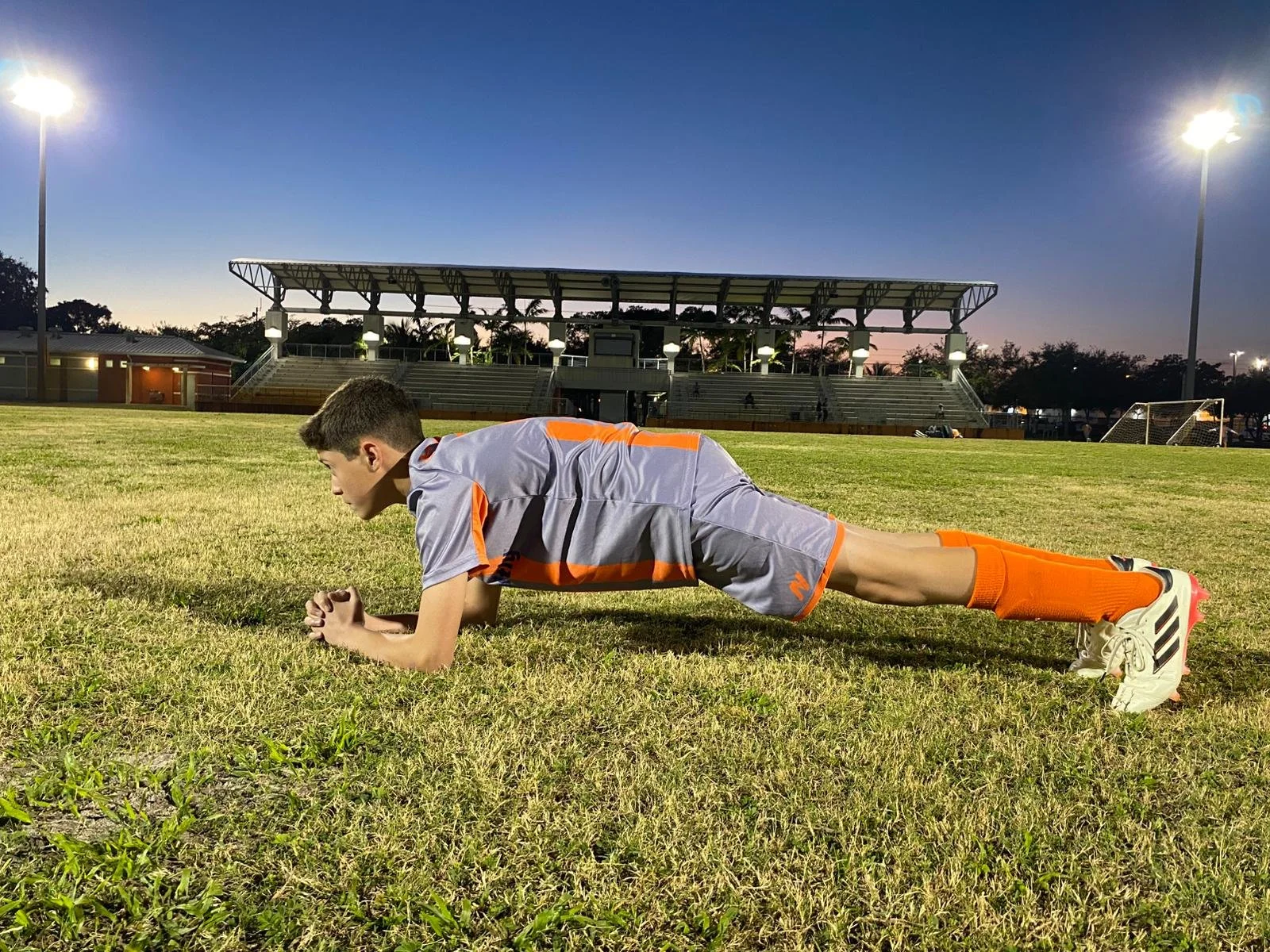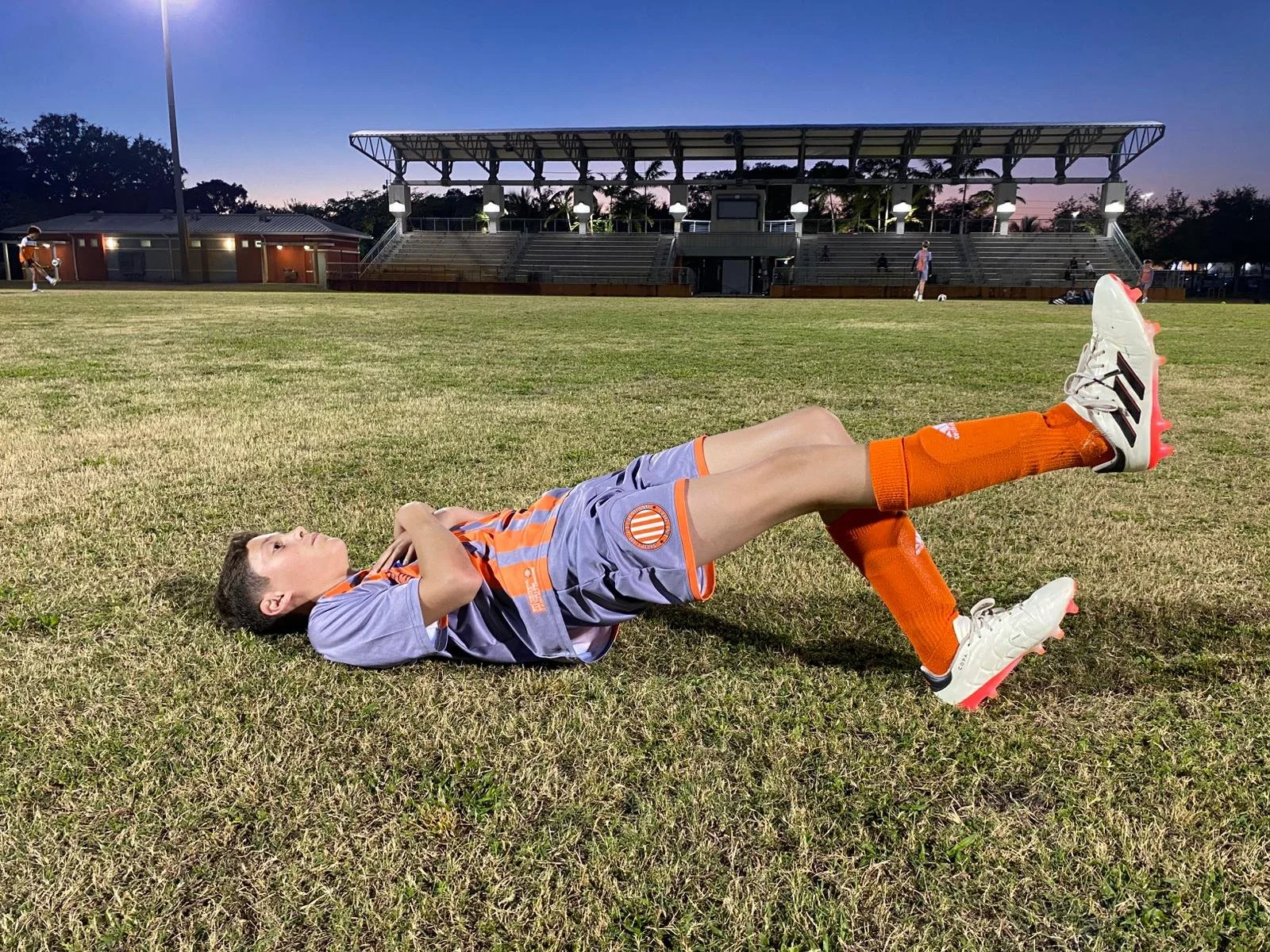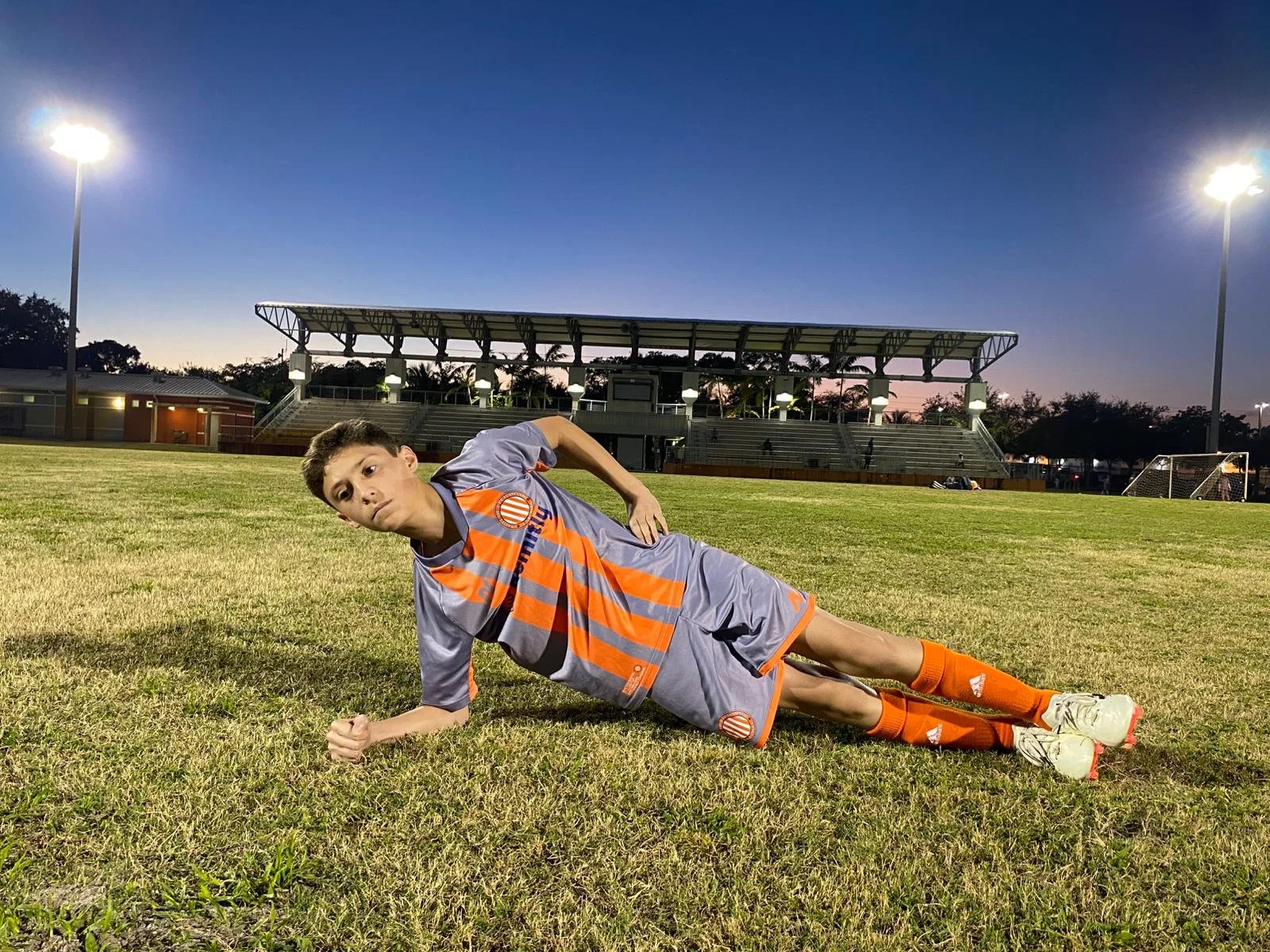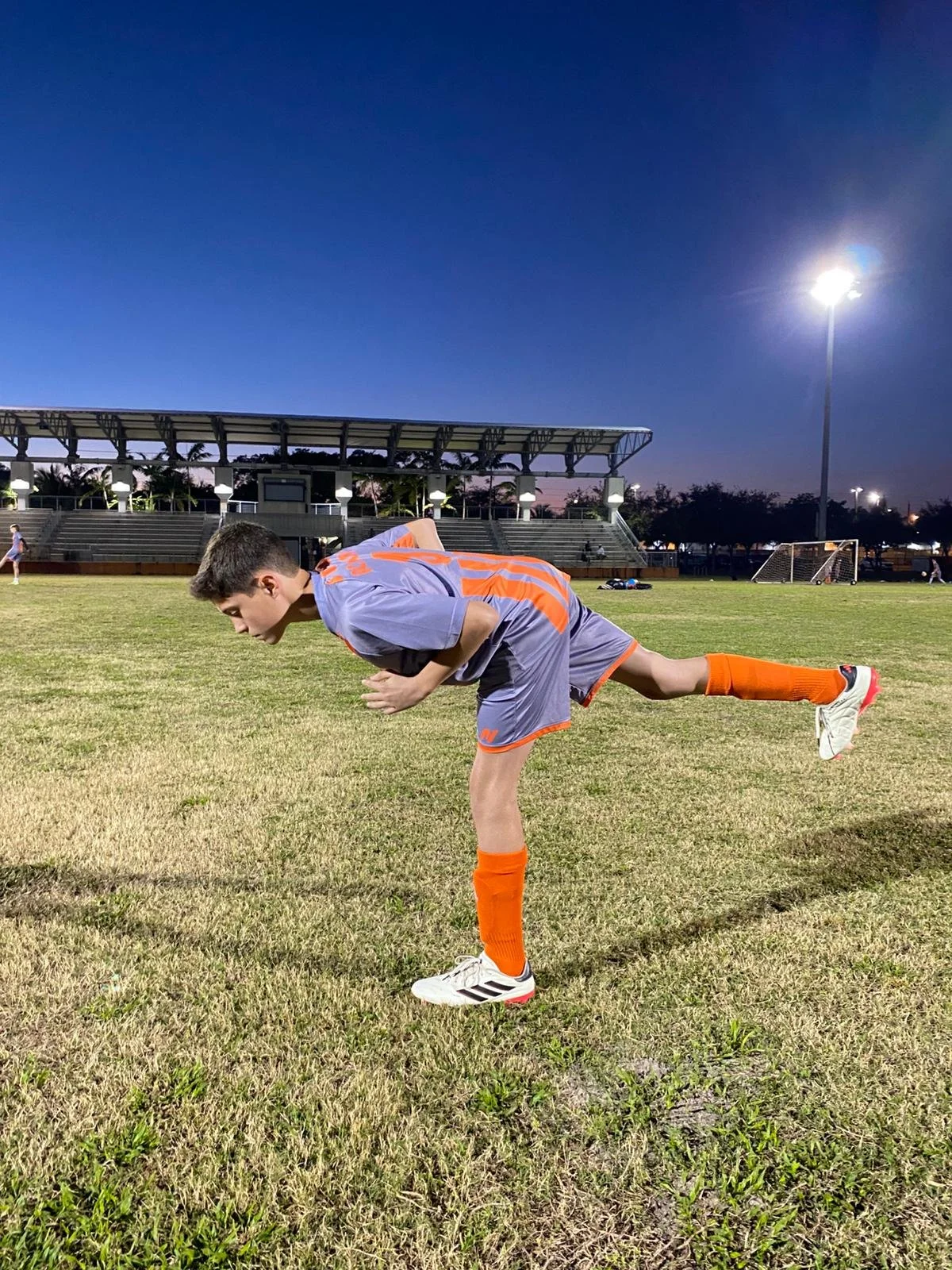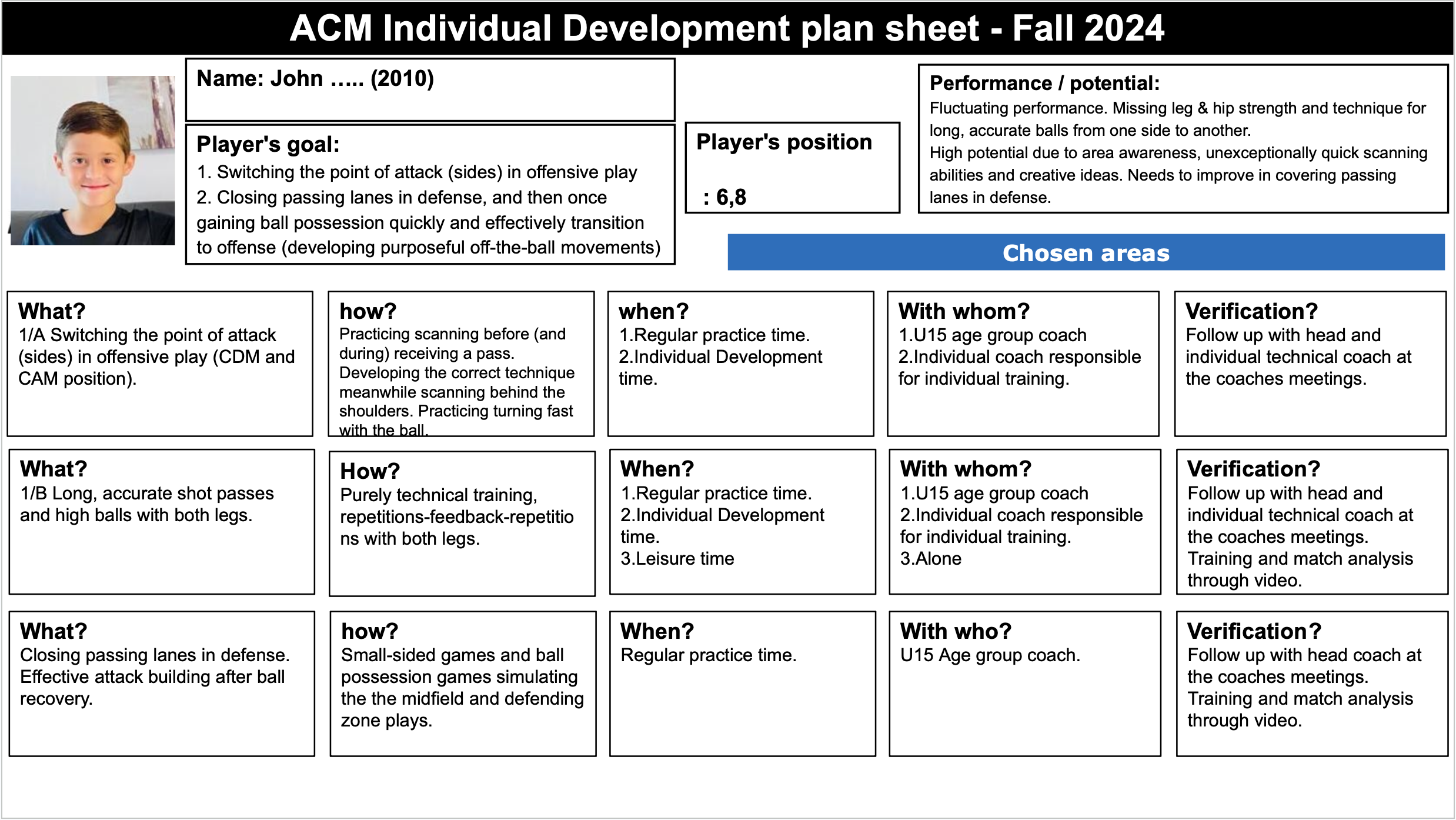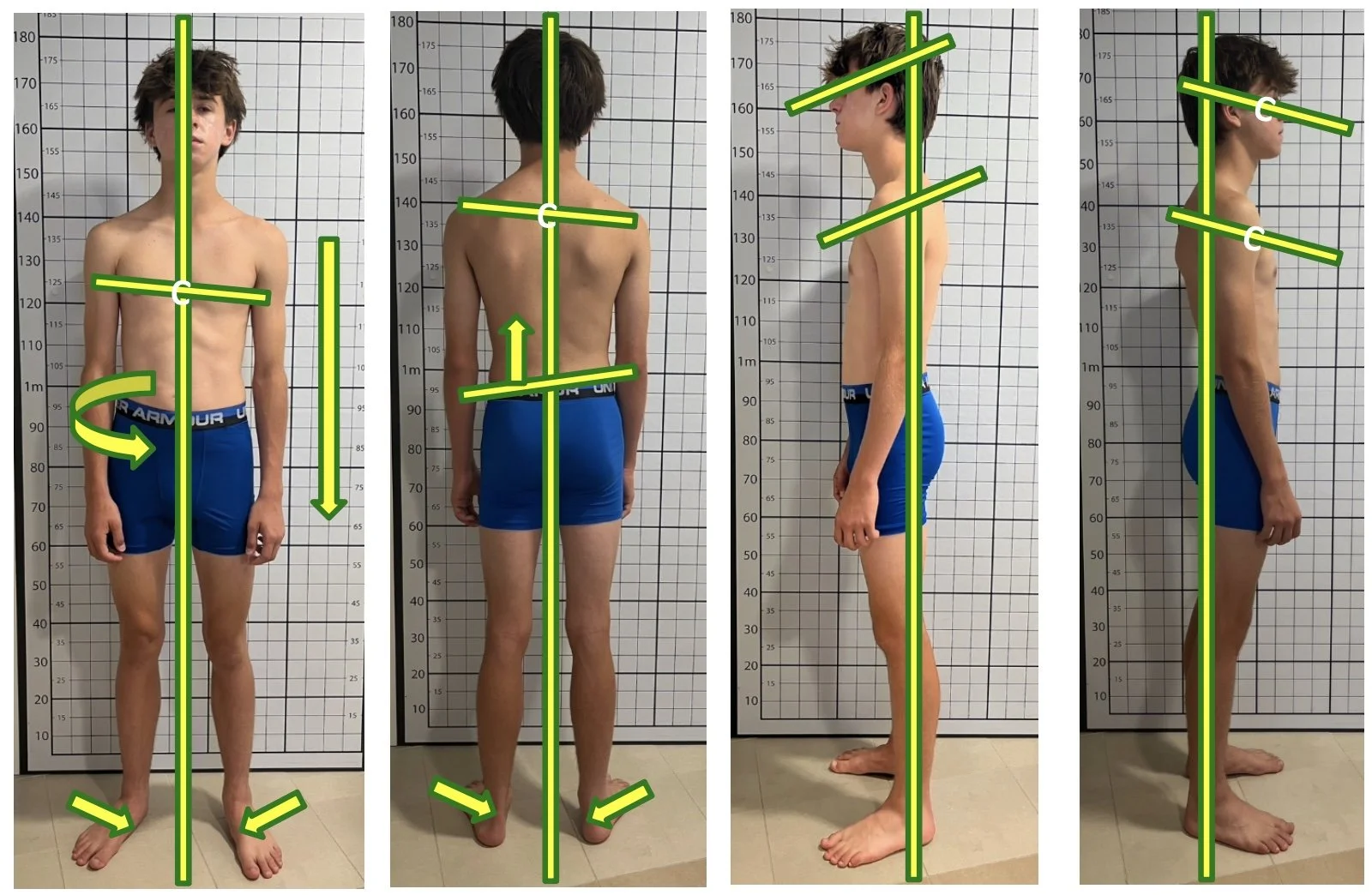5) Data & Player Insights
Individual Development Plan
At our club the Individual Development Plan (IDP) process begins with selection of the players that ACM considers as potential top performing adults; or players whom require immediate personal care to adapt/catch up to our top teams’ teachnical/tactical level. After the selection the next is goals setting by the head coach (or may be the scout), the individual coach and the Director of Coaching., where the professionals define clear objectives for growth. This is followed by self-assessment, allowing players to reflect on their strengths and areas for improvement. Feedback is provided by coaches for parents & players to identify skill gaps, and together, they determine the necessary resources and strategies to address these gaps and support continued development.
Examples of IDP (Individual Development Plan) used for player development
Area of John O’Donovan’s hip inflamation.
John O’Donovan (2010), one of our dedicated soccer players - who has been part of our IDP since 2019 - had been struggling with chronic hip and lower back pain for several months, keeping him off the field.
During his assessment, it was discovered that John had a significant leg length discrepancy and hip asymmetry, issues that unfortunately occur in a small percentage of growing children. Given the impact these conditions had on his soccer performance and overall well-being, it was crucial to implement a soccer-specific rehabilitation and development plan to support his recovery.
John began working with Coach Peter, our Head of Physio Group, a skilled human kinesiologist and movement therapist. With deep expertise in soccer-specific movement mechanics and rehabilitation, Coach specializes in addressing musculoskeletal issues in athletes. The process began with a thorough evaluation of John’s movement patterns, identifying the underlying causes of his pain, including muscle imbalances, postural asymmetries, and limitations in sprint and agility movements essential for soccer.
AC Miami Individual Development Plan sheet - Fall 2024
Following the assessment, Coach designed a tailored program that focused on corrective exercises aimed at addressing the leg length discrepancy and hip asymmetry. The initial phase of rehabilitation included gentle, low-impact movement therapy sessions to help John reduce the pain in his hips and lower back. These sessions incorporated mobility exercises, strengthening routines for the core and lower body, as well as flexibility work to improve joint mobility and restore balance. Soccer-specific drills, such as ball-handling exercises and technical elements like dribbling, were gradually integrated to maintain his connection to the sport.
Over the next 4-6 weeks, John’s pain gradually decreased as he adapted to the therapeutic exercises. Progress was carefully tracked with regular check-ins to ensure the rehabilitation was effective and his condition was improving. As his pain subsided, Coach introduced soccer-specific elements into the plan, incorporating sprint and agility drills, dynamic movements that mimicked game situations, and technical drills like ball dribbling. These additions not only prepared John for his return to the field but also enhanced his soccer-specific skills.
By the end of the 6-week period, John was able to return to team training sessions. His recovery was not just about healing the injury but also about building strength, improving his movement mechanics, and preventing future issues. The tailored soccer-specific rehabilitation process demonstrated the power of an individualized approach, enabling John to overcome a challenging period and continue progressing as a player with renewed confidence.
This, however, is not the end of John’s recovery. Ongoing work is essential to address the root causes of his pain and prevent further issues. He will continue working with Coach to reinforce corrective exercises, improve soccer-specific strength and flexibility, and maintain proper movement patterns. Regular follow-ups will ensure he remains injury-free and performs at his best on the pitch in the long term.
Richard, born in 2010 and playing as a right back, aims to improve his defensive play and ball progression on the flanks, focusing on deep runs and crossing accuracy. He is identified as a player with high performance and potential, making his development a priority.
During weekdays, Richard participates in one training session per day, tailored to address specific aspects of his game. On Mondays, the focus is on ball possession and ball recovery. Training sessions include possession drills, small-sided games, and inter-positional exercises. These are conducted with his age-group coach and the individual development coach. The starting point for these sessions comes from match-based video analysis, identifying key areas for improvement observed during competitive games.
Tuesdays are dedicated to improving his attacking contributions, particularly crossing and positioning in the final third. Position-specific drills simulate match scenarios such as overlaps, deep runs, and cutbacks. Tactical coaches and the age-group coach oversee the training, using insights gained from game footage to refine his performance.
On Wednesdays, defensive tactics take precedence. Richard works on one-on-one duels, defensive positioning, and small-group defensive exercises. These sessions are designed to address challenges highlighted in match analysis, with his age-group coach providing targeted feedback to improve his defensive reliability.
Thursdays combine strength training and decision-making exercises. The strength coach designs gym-based workouts focusing on core and lower-body strength. Decision-making drills are integrated into small-sided games, using real match situations as a framework to help Richard improve his responses under pressure.
Fridays are used for tactical awareness and match preparation. Full-team tactical drills and match simulations emphasize his defensive role and positioning, aligning with findings from game footage to prepare him for future competitions. The tactical staff and team coach provide guidance to ensure his progression in these areas.
On weekends, Richard engages in individual development sessions. Saturdays are focused on technical skills, such as crossing, first-touch improvement, and passing accuracy. These sessions are personalized and guided by his individual development coach. Sundays are dedicated to recovery and mental preparation, combining light recovery exercises and mobility work with video-based tactical reviews, helping Richard process game situations and prepare mentally for the following week.
This structured development plan ensures that Richard's training is closely tied to his match performance, leveraging video analysis to address specific needs and provide a well-rounded approach to his growth as a player.
Phoenix Hall, an active player, sought help to address challenges with movement efficiency and occasional discomfort during physical activities.
During the initial evaluation, a few imbalances in posture and movement patterns were identified, which were contributing to inefficient movement and a higher risk of potential injuries.
The assessment revealed a slight misalignment in pelvic position and noticeable differences in how Phoenix distributed weight between the two sides of the body. Additionally, Phoenix’s shoulders were slightly rounded forward, and overall flexibility, particularly in the hamstrings, was limited. Some difficulty was also observed during basic movements like squats and lunges, where stability and balance were challenged.
To address these issues, a customized plan was created focusing on improving posture, increasing flexibility, and building stability. The program began with gentle stretches and exercises designed to release tight muscles and improve joint mobility. Particular attention was given to improving balance and control during everyday movements like walking, bending, and standing up.
As Phoenix progressed, exercises became more dynamic, incorporating resistance and movements that mimicked real-life activities. These exercises not only helped improve strength and coordination but also boosted confidence in performing physical tasks without discomfort.
After a short period of consistent, focused effort, Phoenix reported feeling more stable and comfortable during workouts and daily activities. Flexibility improved noticeably, and movements felt more natural and controlled. This case highlights how targeted exercises and a focus on functional movement can make a significant difference in improving overall movement quality and reducing discomfort, helping individuals feel and perform better in their daily lives.
Describe IDP process between staff and players
At AC Miami the Individual Development Plan (IDP) process begins with selection of the players that ACM considers as potential top performing adults; or players whom require immediate personal care to adapt/catch up to our top teams’ teachnical/tactical level. After the selection the next is goals setting by the head coach (or may be the scout), the individual coach and the Director of Coaching., where the professionals define clear objectives for growth. This is followed by self-assessment, allowing players to reflect on their strengths and areas for improvement. Feedback is provided by coaches for parents & players to identify skill gaps, and together, they determine the necessary resources and strategies to address these gaps and support continued development.
Staff and players engage in initial discussions to identify both short-term and long-term goals. These goals should follow the SMART criteria — Specific, Measurable, Achievable, Relevant, and Time-bound — to ensure clarity and focus. Once the goals are set, a self-assessment is conducted where players and staff evaluate their current skills, strengths, and areas for improvement. Coaches or supervisors then provide constructive feedback based on observations and performance metrics. This feedback helps identify skill gaps, which highlight the differences between current abilities and desired performance levels. It is essential to determine what resources such as training programs, workshops, and mentorship are available to support development.
An action plan is then created, outlining specific actions, timelines, and resources needed to achieve the set goals. Staff and players collaborate to ensure mutual understanding and commitment to the plan. Once the plan is in place, training and development activities, including scheduled sessions, workshops, or practical experiences, are implemented as outlined. Regular check-ins are scheduled to monitor progress, address challenges, and adjust the plan as necessary.
Monitoring and evaluation are continuous throughout the process, with progress tracked through regular evaluations and performance assessments. A feedback loop is maintained to provide ongoing feedback, ensuring continuous improvement. At the end of a predefined period, the IDP is reviewed to assess what has been achieved and what needs further work. Goals are then adjusted based on the review, modifying the action plan to reflect new aspirations or changing circumstances. Documentation of the IDP process, including goals, progress, and feedback, is maintained to inform future planning.
The benefits of the IDP process include tailored development that caters to individual needs, enhanced engagement through involvement in the development process, and clear pathways that provide a roadmap for personal and professional growth. This collaborative process not only fosters individual growth but also enhances team dynamics and overall performance within the organization or sports team.
Describe how player development is individualized
Player development in soccer is a highly individualized process that takes into account each player's unique strengths, weaknesses, and aspirations. Assessment and evaluation are the foundation of this process. Coaches conduct regular evaluations to assess technical abilities, tactical understanding, physical fitness, and psychological resilience. Performance metrics, including video analysis and statistics, are used to track progress and pinpoint areas for improvement.
Personalized training plans are created based on each player's assessment, focusing on specific skills such as dribbling, passing, shooting, or defensive techniques. Players collaborate with coaches to set personal goals that are realistic and aligned with their long-term aspirations. Training is also customized to emphasize role-specific skills. For example, strikers may focus on finishing, while defenders work on positioning and tackling. Players also receive tactical training to understand the demands of their specific roles within the team’s system.
Mental and emotional support is an integral part of player development. Psychological training techniques are incorporated to enhance focus, resilience, and confidence. Individual counseling sessions provide a space for players to discuss personal challenges, motivations, and mental health, fostering a supportive environment.
Continuous feedback is provided to help players understand their development journey. Open dialogue is encouraged, allowing players to express their thoughts and feelings about their training. Flexibility is essential in player development, as training regimens are updated regularly to reflect changes in a player’s physicality or skill set. Holistic development is prioritized, ensuring attention to not only soccer skills but also life skills such as teamwork, leadership, and communication.
The involvement of support staff is crucial to the process. Specialists, such as nutritionists, physiotherapists, and strength and conditioning coaches, work together to address specific needs. In youth development, involving parents and community resources can further support a player’s growth outside of training.
By focusing on these individualized elements, soccer programs can optimize player development, creating more well-rounded athletes who are better prepared for both competitive play and personal growth.



